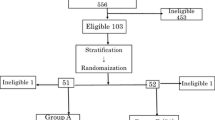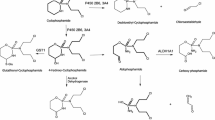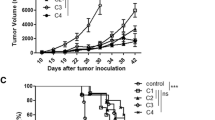Summary
We investigated the combined effects of human recombinant interleukin 2 (IL-2) and cyclophosphamide (CY) on s.c. transplanted 3LL lung carcinoma in C57BL/6 mice. A total of 95% of the tumors were competely cured when CY (150 mg/kg, i.v.) was given on day 5 (5 days after tumor implantation) and IL-2 (5×104 Jurkat Units/day, i.p.) was then combined with it between day 6 and day 15. CY alone brought about the complete regression of tumors, although 60% of the mice died of local recurrence and pulmonary metastasis; IL-2 alone had no therapeutic effect. Satisfactory effects from the combination of CY and IL-2 were also obtained by 5 days administration of IL-2 between days 11 and 15, initiated 6 days after CY treatment, but not by that given before CY (days 1–5) or 1 day after CY (days 6–10). No therapeutic effects from IL-2 were observed when it was combined with other types of chemotherapy that showed not therapeutic effects by themselves. Nor were we able to observe any transplantation resistance to the rechallenge of 3LL tumor in cured mice. We particularly examined the lymphokine-activated killer (LAK) cells as we suspected that these were responsible for the development of active effector cells in the treated mice. LAK cell activity in fresh spleen cells was detected in mice treated with IL-2 alone but not in untreated mice nor in those treated with CY alone or CY plus IL-2. The number of LAK precursor cells in the spleen had increased on day 8 and on day 13 in untreated mice with 3LL, as compared with the incidence in normal mice, while the number of cells had decreased by day 18. On the other hand LAK precursor cells were suppressed on day 8 and tended to recover thereafter in CY-treated mice. Adoptively transferred LAK cells were found to accumulate in CY-treated tumors 2.5 times more densely than in untreated tumors. The preferential accumulation of LAK cells that had been activated systemically by the appropriately timed administration of IL-2 in tumor tissue was followed by the improved effects obtained by combined treatment with CY and IL-2.
Similar content being viewed by others
References
Cheever MA, Greenberg PD, Fefer A, Gillis S (1982) Augmentation of the antitumor therapeutic efficacy of long-term cultured T lymphocytes by in vivo administration of purified interleukin 2. J Exp Med 155:968
Cheever MA, Thompson JA, Kern DE, Greenberg PD (1985) Interleukin 2 (IL-2) administered in vivo: influence of IL-2 route and cell growth. J Immunol 134:3895
Devos R, Plaelinck G, Cheroute H, Simons G, Degrave W, Tayernier J, Remaut E, Fiers W (1983) Molecular cloning of human interleukin 2 CDNA and its expression in E. coli. Nucl Acids Res 11:4307
Donohue JH, Rosenberg SA (1983) The fate of interleukin 2 after in vivo administration. J Immunol 130:2203
Donohue JH, Rosenstein M, Chang AF, Lotze MT, Robb RJ, Rosenberg SA (1984) The systemic ability of sensitized murine lymphocyte lines to culture a disseminated syngeneic lymphoma. J Immunol 132:2123
Hefeneider SH, Colon PJ, Henney CS, Gillis S (1983) In vivo interleukin 2 administration augments the generation of alloreactive cytotoxic T lymphocytes and resident natural killer cells. J Immunol 130:222
Hengst JCD, Mokyr MD, Dray S (1980) Importance of timing in cyclophosphamide therapy of MOPC-315 tumor-bearing mice. Cancer Res 40:2135
Hosokawa M, Morikawa K, Okada F, Kobayashi H (1986) An enhanced therapeutic effect in the treatment of rat transplanted tumors by mixing interleukin-2 in a Pluronic gel. Host Defence mechanism against Cancer Urushizaki I, Aoki T, Tsubura E (eds) Excerpta Med Inter Cong Ser 738:26
Ishizuka M, Takeuchi T, Masuda T, Fukasawa S, Umezawa H (1981) Enhancement of immune responses and possible inhibition of suppressor cells by aclacinomycin. J Antibiot 34:331
Kataoka T, Ogihara K, Sakurai Y (1980) Immunoprophylactic and immunotherapeutic response by concanavalin A-bound tumor vaccine enhanced by chemotherapeutic agents eliminating possible suppressors. Cancer Res 40:3839
Kataoka T, Oh-Hashi F, Sakurai Y, Ogihara K (1981) Effect of antineoplastic by concanavalin A-bound tumor vaccine. Cancer Res 41:5151
Lafreniere R, Rosenberg SA (1985) Successful immunotherapy of murine experimental hepatic metastases with lymphokine-activated killer cells and recombinant interleukin 2. Cancer Res 45:3735
Mantovani A, Luini W, Peri G, Vecchi A, Spreafico F (1978) Effect of chemotherapeutic agents on natural cell-mediated cytotoxicity in mice. J Natl Cancer Inst 61:1255
Mazumder A, Rosenberg SA (1984) Successful immunotherapy of natural killer-resistant established tumor depends on elimination of tumor-induced suppressor T cells. J Exp Med 55:1603
Merluzzi UJ, Walker MM, Faanes RB (1981) Inhibition of cytotoxic T-cell clonal expansion by cyclophosphamide and the recovery of cytotoxic T-lymphocyte precursors by supernatants from mixed-lymphocyte culture. Cancer Res 41:3663
Minami A, Mizushima Y, Takeichi N, Hosokawa M, Kobayashi H (1979) Dissociation of anti-tumor immune response in rats immunized with solubilized tumor-associated antigens from a methylcholanthrene induced fibrosarcoma. Int J Cancer 23:358
Mizushima Y, Sendo F, Miyake T, Kobayashi H (1981) Augmentation of specific cell-mediated immune responses to tumor cells in tumor-bearing rats pretreated with the antileukemic drug Busulfan. J Natl Cancer Inst 66:659
Mizushima Y, Sendo F, Takeichi N, Hosokawa M, Kobayashi H (1981) Enhancement of antitumor transplantation resistance in rats by appropriately timed administration of busulfan. Cancer Res 41:2917
Mizushima Y, Yuhki N, Hosokawa M, Kobayashi H (1982) Diminution of cyclophosphamide-induced suppression of antitumor immunity by an immunomodulator PS-K and combined therapeutic effects of PS-K and cyclophosphamide on transplanted tumor in rats. Cancer Res 42:5176
Mizushima Y, Koga Y, Yuhki N, Kobayashi H (1983) The therapeutic effect of the antileukemia drug busulfan as an immunomodulator on transplanted fibrosarcoma KMT-17 in WKA rats. Gann 74:162
Morikawa K, Hosokawa M, Hamada J, Sugawara M, Kobayashi H (1985) Host-mediated therapeutic effects produced by appropriately timed administration of bleomycin on rat fibrosarcoma. Cancer Res 45:1502
Morikawa K, Hosokawa M, Hamada J, Xu Z-Y, Kobayashi H (1986) Possible participation of a tumoricidal macrophages in the therapeutic effect of bleomycin on a transplantable rat fibrosarcoma. Cancer Res 46:684
Morikawa K, Okada F, Hosokawa M, Kobayashi H (1987) Enhancement of therapeutic effects of recombinant interleukin 2 on a transplantable rat fibrosarcoma by the use of sustained release vehicle, Pluronic gel. Cancer Res 47:37
Mokyr MB, Hengst JCD, Dray S (1982) Role of antitumor immunity in cyclophosphamide-induced rejection of subsutaneous nonpalpable MOPC-315 tumor. Cancer Res 42:974
Mule JJ, Shu S, Schwartz SL, Resenberg SA (1984) Successful adoptive immunotherapy of established pulmonary metastases of multiple sarcomas with lymphokine-activated killer cells and recombinant interleukin 2. Science 225:1487
Nakajima H, Abe S, Masuko Y, Tsubouchi J, Yamazaki M, Mizuno D (1981) Elimination of tumor-enhancing cells by cyclophosphamide and its relevance to cyclophosphamide therapy of murine mammary tumor. Gann 72:723
Nishimura T, Togashi Y, Goto M, Yagi H, Uchiyama Y, Hashimoto Y (1986) Augmentation of the therapeutic efficacy of adoptive tumor immunotherapy by in vivo administration of slowly released recombinant interleukin 2. Cancer Immunol Immunother 21:12
Nomi S, Pellis NR, Kahan BD (1984) Retardation of postsurgical metastases with the use of extracted tumor-specific transplantation antigens and cyclophosphamide. J Natl Cancer Inst 73:943
North RJ (1982) Cyclophosphamide-facilitated adoptive immunotherapy of an established tumor depends on elimination of tumor-induced suppressor T cells. J Exp Med 155:1063
Ogura T, Shindo H, Shinzato O, Namba M, Masuno T, Inoue T, Kishimoto S, Yamamura Y (1982) In vitro tumor cell killing by peritoneal macrophages from mitomycin C-treated rats. Cancer Immunol Immunother 13:112
Rosenberg SA, Lotze MT, Muul LM, Leitnan S, Chang AE, Ettinghansen SE, Matory YL, Skibber JM, Shiloni E, Vetto JT, Seipp CA, Simpson C, Reichhert CM (1985) Observations on the systemic administration of autologous lymphokine-activated killer cells and recombinant interleukin-2 to patients with metastatic cancer. N Engl J Med 313:1485
Rosenberg SA, Mule JJ, Spiess PJ, Reichert CM, Schwartz SL (1985) Regression of established pulmonary metastasis and subcutaneous tumor mediated by the systemic administration of high-dose recombinant interleukin 2. J Exp Med 161:1169
Terashima M, Takeichi N, Suzuki K, Itaya T, Gotohda E, Kobayashi H (1980) Enhanced immunogenicity of xenogenized tumor cells in rats pretreated with cyclophosphamide. Tohoku J Exp Med 132:335
Author information
Authors and Affiliations
Additional information
Supported in part by Grants-in-Aid for Cancer Research from the Japanese Ministry of Education, Science and Culture and from the Japanese Ministry of Health and Welfare
Rights and permissions
About this article
Cite this article
Hosokawa, M., Sawamura, Y., Morikage, T. et al. Improved therapeutic effects of interleukin 2 after the accumulation of lymphokine-activated killer cells in tumor tissue of mice previously treated with cyclophosphamide. Cancer Immunol Immunother 26, 250–256 (1988). https://doi.org/10.1007/BF00199937
Received:
Accepted:
Issue Date:
DOI: https://doi.org/10.1007/BF00199937




